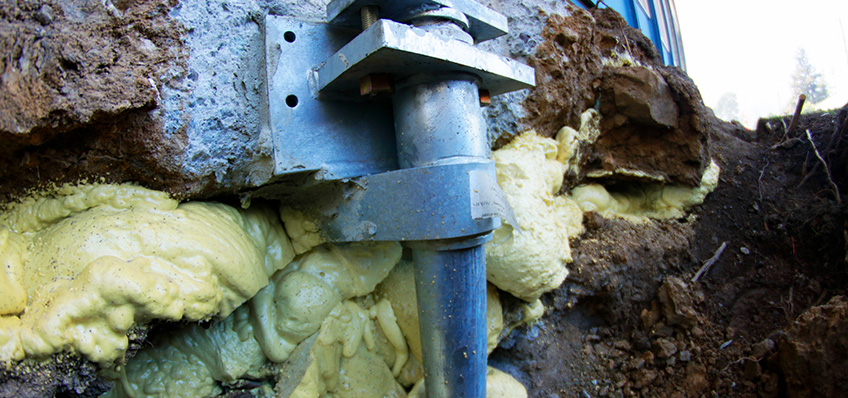Complimenting Steel Underpinning Solutions
Polyurethane injection is the process in which a liquid geotechnical polyurethane solution is injected into the soil. The polyurethane permeates the soil and begins to expand as it cures, binding with loose soils to create a dense matrix that is strong enough to lift sinking or settling concrete slabs. Polyurethane can provide outstanding lift results in the right circumstances, but on its own, it is not as reliable as steel underpinning for foundation repair, however it is a perfect complement.

Underpinning is a foundation repair process that uses piering systems (steel, helical, or concrete) to lift and stabilize the foundation of a structure. Engineers typically prefer steel underpinning because the design is analytical, the results are measurable, and the repair is long-lasting (EagleLIFT offers a lifetime warranty on its steel underpinning projects). However, steel underpinning isn’t perfect.
When the piers are used to lift, gaps often form between the support soil and the foundation. Additionally, underpinning does not address the weak soils that are the typical culprit of the foundation issue. Underpinning solutions are a workaround by bypassing the problem and getting to deeper and more stable strata. But the foundation, and more importantly, the interior floors, still need to have a connection to the soil for both structural support and to remove gaps that could lead to further soil loss or homes for unwanted wildlife.
The solution for overcoming these limitations is polyurethane injection. Geotechnical polyurethanes are exceptional for soil grouting. When injected into the soil, the chemical initially permeates voids and weak soil zones in a liquid form and then expands to fill and densify the gaps. This process works well with steel underpinning, in that it stabilizes the loose soils, fills any present voids, and restores the soil connection to the foundation. If the soil is weak at depth, a process called Deep Strata Injection can be used to increase the soil bearing capacity all the way down to 25 feet.
In addition to void filling and soil stabilization, Polyurethane injection can be used to stabilize, lift, and level interior footers and floors. This process is substantially cheaper and less invasive than using underpinning. Polyurethane injection requires no excavation and will help match the interior floor level to the newly stabilized exterior.
Can Polyurethane be used to Stabilizing Exterior Footers?
If there is not significant structural settlement, Deep Strata Injection can be used to densify and stabilize soils around footers. In optimal conditions where issues like erosion and soil subsidence are causing the problem at surface level or main strata, polyurethane can be used to lift footers back to level and/or stabilize against future soil loss. However, this process is not nearly as stable or long-lasting as steel underpinning and is susceptible to compression or problems related to deeper strata related problems.

As in all situations with foundations, a qualified engineer should evaluate the project before work is performed. Both underpinning and polyurethane injection results can vary due to the soil types at hand. Contact EagleLIFT today to schedule a consultation for your foundation repair project.

